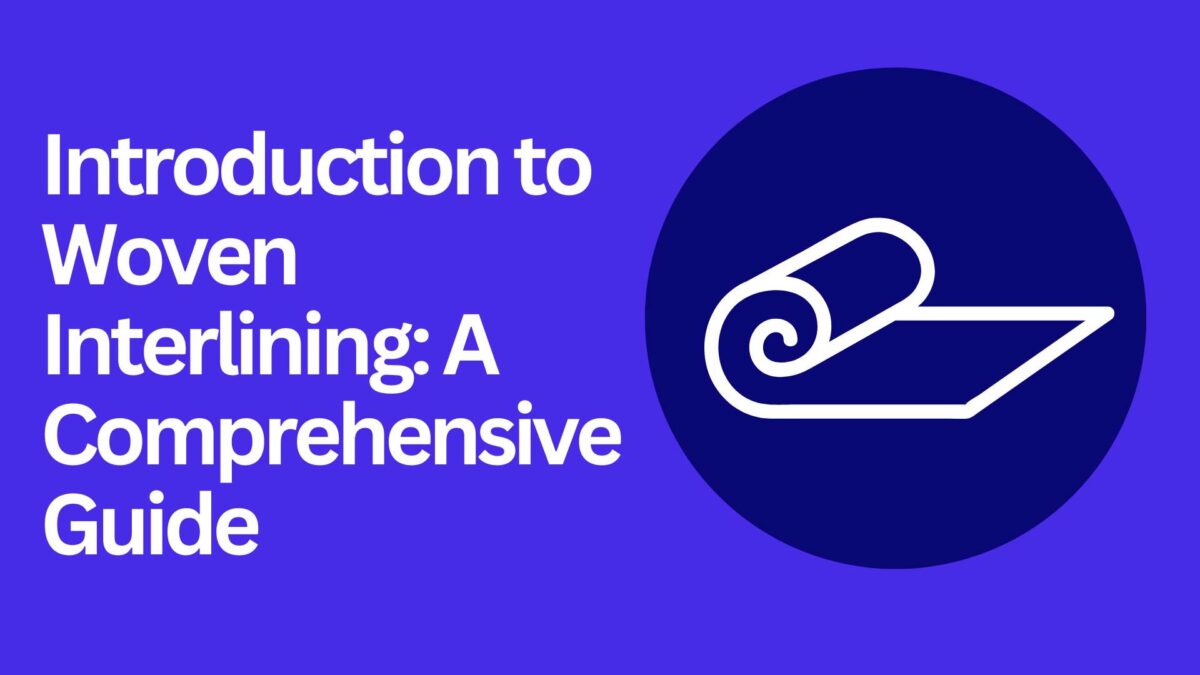Exploring Non-Woven Interlining: A Comprehensive Guide
Introduction
Have you ever dreamt of crafting garments that rival store-bought pieces in their impeccable structure and polished finish? The secret weapon behind that professional look might be hiding beneath the surface – non-woven interlining! This unsung hero plays a vital role in elevating your sewing projects by adding essential body, stability, and a touch of magic that transforms your creations.
But the world of non-woven interlining can feel like a labyrinth, filled with various types, weights, and applications. Fear not, sewing enthusiast! This comprehensive guide will be your compass, demystifying the different types of non-woven interlining, exploring weight options, and guiding you on their ideal uses. With this knowledge in hand, you’ll be well-equipped to choose the perfect interlining for any project, ensuring your garments boast a flawless finish that speaks volumes about your sewing prowess.
Table of Contents
- What is Non-Woven Interlining
- Non-Woven Interlining Weights
- Applications of Non Woven Interlining
- Troubleshooting Common Issues with Non-Woven Interlining
- The Benefits of Using Non-Woven Interlining
- Conclusion
What is Non-Woven Interlining?
Unlike its woven counterpart, non-woven interlining isn’t constructed from interlaced threads. Instead, it’s formed through a unique process where fibers are bonded together using heat, pressure, or chemical adhesives. This captivating approach results in a soft, sheet-like material with a range of properties that enhance the functionality and aesthetic of your garments.
A World of Non-Woven Interlining Options
Now, let’s delve into the diverse types of non-woven interlining at your disposal:
- Pellon: A household name synonymous with non-woven interlining, Pellon offers a vast array of types catering to various needs and preferences. Their offerings come in diverse weights and textures, ensuring you find the perfect match for your project.
- Fleece Interlining: Craving warmth and a touch of cozy structure? Look no further than fleece interlining. This delightful option is ideal for winter wear, adding a comforting layer of body while creating a defined silhouette. Think cozy jackets, vests, and structured cardigans.
- Stabilizer: Lightweight fabrics often require a delicate touch when it comes to interlining. Enter stabilizer, a lightweight and supportive option perfect for adding structure without sacrificing the beautiful drape of your fabric. It’s a savior for collars, cuffs, buttonholes, and any areas needing a touch of reinforcement without added bulk.
- Double-Sided Fusible Interlining: Efficiency meets convenience with double-sided fusible interlining. Featuring a heat-activated adhesive on both sides, this interlining allows for a breeze-like application process. Simply sandwich it between your fabric and lining, apply heat with an iron, and voila! You’ve achieved a secure and professional-looking bond.
- Mesh Interlining: For projects where breathability is key, mesh interlining comes to the rescue. This lightweight option provides a touch of structure without compromising the delicate drape of sheer fabrics. Think elegant blouses, flowy dresses, and garments where you want some shaping without compromising on a light and airy feel.

Non-Woven Interlining Weights
Just like woven interlining, non-woven options come in a spectrum of weights, each specifically suited for distinct applications:
- Lightweight: Delicate fabrics deserve gentle support. Lightweight interlining is your champion, offering a touch of structure without compromising the natural drape of your fabric. It’s ideal for use with silks, chiffons, and other lightweight materials, especially in areas like collars and yokes where a bit of shaping is desired.
- Mediumweight: The “go-to” option for most sewing projects, mediumweight interlining offers a versatile balance of structure and support. It’s perfect for general-purpose interlining needs, providing excellent reinforcement for collars, cuffs, waistbands, and lightweight jackets. Think crisp shirt collars, structured pockets, and defined waistlines on dresses and skirts.
- Heavyweight: Heavier fabrics and projects requiring significant structure demand a heavyweight interlining. This option provides the necessary support and stability for outerwear, bags, and projects like structured jackets or tailored coats. It ensures your garment retains its shape and maintains a professional look, even with heavier materials.
Applications of Non Woven Interlining
Now that you’re armed with knowledge about types and weights, let’s explore how to choose the perfect non-woven interlining for your specific project:
Garment Type: The level of structure required by your garment is a crucial factor. Blazers and jackets demand a medium to heavyweight interlining for a defined silhouette. Shirts might utilize a lightweight option for collars and cuffs, while dresses might require lightweight to mediumweight interlining for bodices or waistbands. Understanding the level of structure your garment needs is the first step towards choosing the right interlining.
Fabric Weight and Drape: Fabric weight and drape play a vital role in interlining selection. Lighter fabrics generally work best with lightweight interlining to maintain their beautiful drape. For example, a flowy chiffon dress wouldn’t benefit from a heavyweight interlining, as it would weigh down the fabric and hinder its natural movement. Conversely, a heavy wool coat requires a heavyweight interlining to provide the necessary structure and maintain its shape over time.
Desired Look: Ultimately, the look you envision for your garment should guide your interlining choice. Do you crave a crisp, structured collar on your shirt? Opt for a mediumweight interlining. Do you prefer a softer drape for your dress bodice? A lightweight interlining might be the perfect fit. By understanding the desired level of structure and drape, you can ensure your interlining selection complements your creative vision.
Beyond the Basics: Advanced Techniques and Considerations
While the core principles remain the same, there are additional factors to consider for more advanced sewing projects or when working with specific materials:
Sew-in vs. Fusible Interlining: Non-woven interlining comes in both sew-in and fusible varieties. Sew-in interlining requires stitching it to your fabric, offering more flexibility during construction for intricate shapes or areas requiring precise placement. Fusible interlining, on the other hand, simplifies the process by adhering to your fabric with heat. This is ideal for flat areas or projects where a smooth, seamless finish is desired.
Interfacing vs. Interlining: The terms “interfacing” and “interlining” are often used interchangeably, but there’s a subtle distinction. Interfacing is typically a heavier, more structured material used for adding significant body and stability to garments like outerwear or bags. Interlining, on the other hand, offers a wider range of weights and is generally used for providing structure and support while maintaining some drape in the fabric.
Working with Knits: Knit fabrics present unique challenges when it comes to interlining. Traditional non-woven interlinings can sometimes add stiffness or restrict the natural stretch of knits. Thankfully, there are specific knit interfacings available that offer support and stability without compromising the drape or stretch of your knit fabric.
Pre-washing Fabrics: Always pre-wash your fabric before attaching interlining to avoid shrinkage mishaps. Fabric shrinkage can cause the interlining to pucker or distort, leading to an unsightly finish.
Testing Your Interlining: Before committing to large-scale application, it’s wise to test a scrap of interlining on your fabric. This allows you to assess the adhesion (for fusible options), drape, and overall compatibility with your chosen materials.
Following Manufacturer’s Instructions: Different non-woven interlining types might have specific application instructions, especially regarding heat settings for fusible options. Always refer to the manufacturer’s recommendations to ensure optimal results.
Troubleshooting Common Issues with Non-Woven Interlining
Even the most seasoned sewists can encounter challenges when working with interlining. Here’s how to troubleshoot some common issues:
Interlining Bubbling: This usually occurs due to improper heat settings or uneven pressure when using fusible interlining. Ensure you follow the manufacturer’s heat recommendations and apply even pressure with your iron.
Interlining Not Sticking: Several factors can contribute to this issue. Dirty fabric surfaces, incorrect heat settings, or using an incompatible interlining type for your fabric can all lead to adhesion problems. Double-check your fabric is clean, adjust heat settings if needed, and ensure you’ve chosen the appropriate interlining weight and type for your project.
Fabric Rippling: This might indicate that the interlining is too heavy for your fabric. Opt for a lighter weight interlining or consider using a stabilizer for areas needing minimal support.
Benefits of Using Non-Woven Interlining
By incorporating non-woven interlining into your sewing projects, you’ll unlock a multitude of benefits that elevate your creations:
- Professional Finish: Non-woven interlining helps eliminate fabric bulk and creates a smooth, polished look, mimicking the quality of store-bought garments.
- Improved Structure: The right interlining provides essential structure and support, ensuring your garments maintain their shape and drape beautifully over time. Crisp collars, defined waistbands, and structured bodices become achievable with the right interlining choice.
- Enhanced Durability: Interlining acts as a reinforcement layer, adding strength and preventing excessive wear and tear on areas like collars, cuffs, and buttonholes. This extends the lifespan of your garments and keeps them looking their best for longer.
- Creative Freedom: Non-woven interlining opens doors to creative exploration in garment construction. By manipulating the type and weight of interlining, you can achieve unique silhouettes, add unexpected details like structured pockets, or create a tailored look for a professional appearance.
- Peace of Mind: The confidence of knowing your garments will drape beautifully and maintain their shape throughout the day is invaluable. Non-woven interlining provides a sense of security and allows you to focus on the creative aspects of sewing, knowing the technical elements are handled.
Conclusion
By demystifying the world of non-woven interlining, you’ve unlocked a powerful tool to elevate your sewing projects. With the knowledge of various types, weights, and application techniques, you’re now equipped to choose the perfect interlining for any garment, ensuring a professional finish and a level of structure that takes your creations to the next level. So, embrace the magic of non-woven interlining, experiment with different options, and get ready to transform your sewing journey!
Link of related Articles

Shweta, a textile designer with a keen eye and deep knowledge of fabrics, translates her passion into unique designs. She loves to share her expertise and ignite a love for textiles in others. Dive into the world of fabrics with Shweta!





